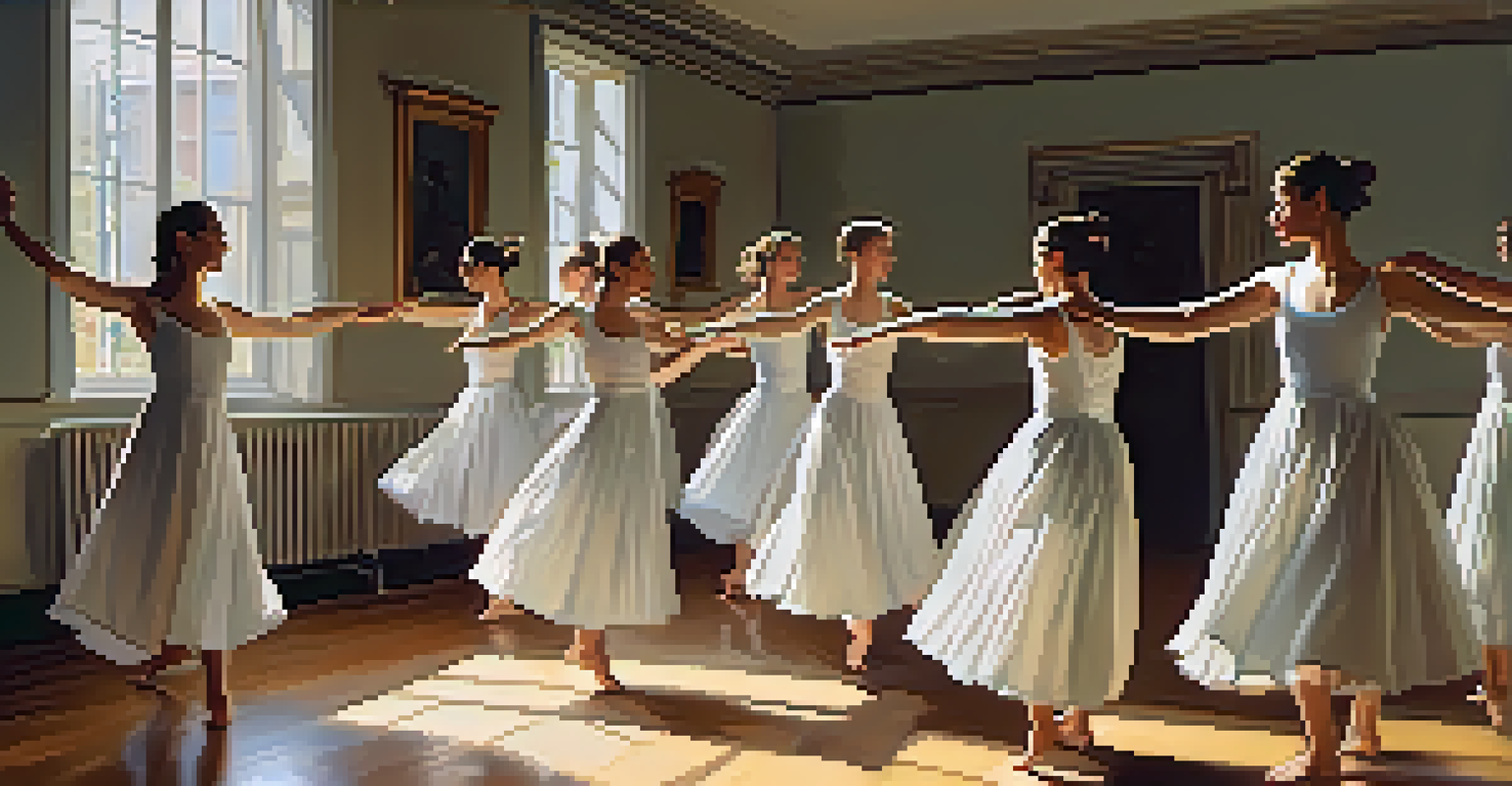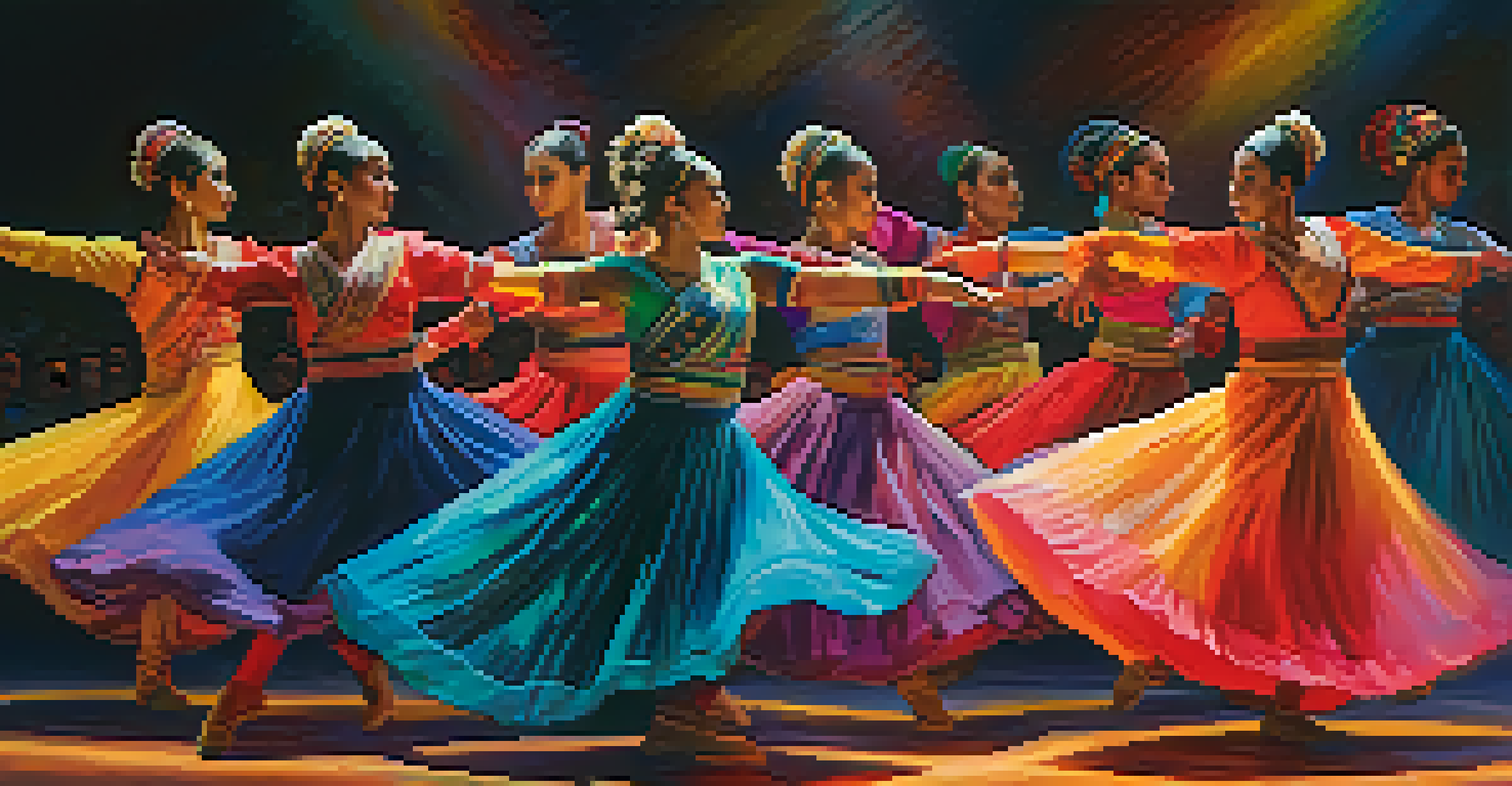The Psychology of Dance: Understanding Movement and Emotion

Dance as a Universal Language of Emotion
Dance is often described as a universal language, transcending cultural barriers to express human emotions. When we watch someone dance, we can often feel what they are feeling, whether it's joy, sadness, or passion. This emotional connection occurs because movement can convey complex feelings that words sometimes cannot capture. For instance, a joyful dance might involve lively, quick movements, while a slow, fluid dance could reflect melancholy. Thus, dance becomes a powerful tool for emotional expression and communication.
Dance is the hidden language of the soul.
The way we move can also reflect our inner emotions. A person who is feeling confident might dance with wide, expansive movements, while someone feeling shy may keep their movements small and contained. This interplay between movement and emotion not only reveals our feelings but can also influence them; dancing can uplift our spirits, making us feel more alive and connected. This duality highlights the profound impact dance has on our psychological state.
Moreover, various dance forms can evoke different emotional responses in both the dancer and the audience. For instance, ballet often conveys grace and elegance, while hip-hop can express rebellion and strength. The cultural context of these dance styles adds another layer, as different cultures have unique ways of interpreting movement and emotion. Ultimately, dance serves as a mirror to our emotional landscape, allowing us to explore and understand our feelings.
The Science Behind Movement and Emotion
Recent studies in psychology and neuroscience have shed light on the connection between movement and emotion. Research shows that engaging in dance can stimulate the release of endorphins, often referred to as 'feel-good' hormones. These chemicals can enhance our mood and reduce feelings of stress or anxiety, demonstrating how movement can positively affect our emotional well-being. Thus, dance can be a therapeutic practice, promoting mental health and emotional resilience.

Furthermore, the concept of embodied cognition suggests that our bodily movements can influence our thoughts and feelings. For example, adopting open, expansive body language can lead to feelings of confidence, while closed-off postures might reinforce feelings of insecurity. This phenomenon can be seen in dance, where the way we physically express ourselves can alter our emotional state both on and off the dance floor. It's an empowering reminder that our bodies play an active role in shaping our mental experiences.
Dance as Emotional Expression
Dance transcends cultural barriers, allowing individuals to express complex emotions that words often cannot capture.
In a broader sense, the interplay between movement and emotion has implications for various fields, from therapy to education. Dance therapy, for instance, utilizes movement to help individuals process emotions and trauma, showcasing the benefits of this connection. By understanding the science behind dance and emotion, we can harness its power to foster healing and personal growth.
Cultural Influences on Dance and Emotion
Dance is deeply embedded in cultural traditions, often reflecting the values and emotions of a society. Different cultures have unique dance styles that tell stories, celebrate events, or express collective feelings. For instance, traditional African dances often celebrate community and ancestry, while flamenco from Spain conveys deep passion and intensity. These cultural nuances highlight how dance serves as a reflection of the emotional fabric of a community.
To watch us dance is to hear our hearts speak.
Moreover, cultural context shapes how individuals interpret and express emotions through dance. What might be seen as playful and joyous in one culture could be interpreted as aggressive or inappropriate in another. This variability underscores the importance of understanding cultural backgrounds when analyzing dance and emotion. Ultimately, dance becomes a dialogue between individual expression and collective identity.
As globalization continues to influence cultural exchanges, we see a blending of dance styles that creates new emotional experiences. For example, hip-hop has roots in African American culture but has evolved to incorporate elements from various global influences. This fusion allows dancers to explore a wider range of emotions and narratives, making dance a continuously evolving form of expression. Through this lens, we can appreciate dance as both a personal and cultural exploration of emotion.
The Role of Dance in Personal Identity
For many individuals, dance is a significant part of their personal identity. From childhood through adulthood, people often associate specific dance styles with their cultural heritage, personal experiences, or even social groups. This connection to dance can shape how individuals view themselves and express their emotions, creating a sense of belonging and self-acceptance. For example, a dancer who participates in their cultural dances may feel a strong sense of pride and connection to their roots.
Moreover, dance can be a vehicle for self-discovery and personal expression. Many dancers use movement to explore their emotions or to process life experiences. This journey of self-exploration can lead to greater emotional awareness and healing, as individuals learn to articulate their feelings through movement. In this way, dance becomes not just a performance, but a powerful tool for personal growth.
Therapeutic Benefits of Dance
Engaging in dance stimulates endorphin release, promoting emotional well-being and serving as an effective therapeutic practice.
Additionally, the sense of community found in dance classes or groups can foster supportive environments where individuals feel safe to express themselves. This camaraderie can enhance emotional well-being, as dancers share their stories and experiences through the art of movement. Thus, dance serves as a catalyst for building personal identity while also nurturing emotional connections with others.
Dance and Emotional Expression in Therapy
Dance therapy has gained popularity as a unique approach to mental health, leveraging the connection between movement and emotion. This therapeutic practice encourages individuals to express their feelings through dance, providing an alternative outlet for those who may struggle with verbal communication. By moving their bodies, participants can unlock deeper emotions, facilitating healing and self-discovery. For many, this form of therapy can lead to breakthroughs that traditional talk therapy might not achieve.
In dance therapy, the focus is on the process rather than the performance. Participants are encouraged to move freely, allowing their bodies to express emotions without judgment. This freedom can lead to transformative moments, where individuals confront and process emotions in a safe space. A simple sway or a powerful leap can provide insights into one's emotional state, making dance a powerful medium for understanding oneself.
Furthermore, dance therapy can be particularly beneficial for individuals dealing with trauma, anxiety, or depression. Movement can act as a release, helping to alleviate pent-up emotions and stress. As individuals explore their feelings through dance, they often find a renewed sense of hope and empowerment. Overall, the integration of dance into therapeutic practices highlights the profound impact movement can have on emotional healing.
The Impact of Music on Dance and Emotion
Music and dance share an inseparable bond, with music often serving as the driving force behind movement. The rhythm and melody of a piece can evoke specific emotions, guiding dancers in how they express themselves. For instance, an upbeat song may inspire energetic movements, while a slow ballad might lead to more graceful, fluid motions. This synergy between music and dance enhances emotional expression, creating a richer experience for both the dancer and the audience.
Additionally, the type of music one listens to can influence mood and motivation. Research shows that certain genres can trigger emotional responses, impacting how we move. For example, listening to classical music might evoke feelings of nostalgia, while contemporary pop can instill a sense of joy and excitement. This relationship illustrates how music not only accompanies dance but also shapes the emotional narrative being conveyed through movement.
Cultural Influence on Dance
Dance reflects and shapes cultural identities, with various styles embodying the emotional narratives of different societies.
Moreover, the interplay between dance and music can create a communal experience, bringing people together in shared emotional moments. Whether it's a wedding dance or a flash mob in a public space, the combination of rhythm and movement fosters connections among participants. Ultimately, the collaboration of music and dance underscores the emotional depth of both art forms, enriching our understanding of human expression.
The Future of Dance and Emotional Connection
As society evolves, so does the art of dance, opening new avenues for emotional expression and connection. With the rise of technology, virtual dance platforms have emerged, allowing individuals to connect and share their movements globally. This new medium not only expands access to dance but also creates diverse spaces for emotional exchange, fostering a sense of community among dancers worldwide. The future of dance lies in its ability to adapt and innovate while maintaining its core emotional essence.
Furthermore, the integration of dance into everyday life continues to grow, with more people recognizing its therapeutic benefits. Schools, workplaces, and wellness programs are increasingly incorporating dance as a means of promoting emotional health and well-being. This shift reflects a broader understanding of the importance of movement in our lives, reinforcing the idea that dance can be a powerful tool for emotional connection and resilience.

As we look ahead, the fusion of traditional dance forms with contemporary styles will likely continue to shape how we express emotions. This blending will create new narratives and emotional landscapes, allowing dancers to explore and communicate their feelings in innovative ways. Ultimately, the future of dance promises to be as dynamic as the emotions it conveys, ensuring its relevance in our lives for generations to come.